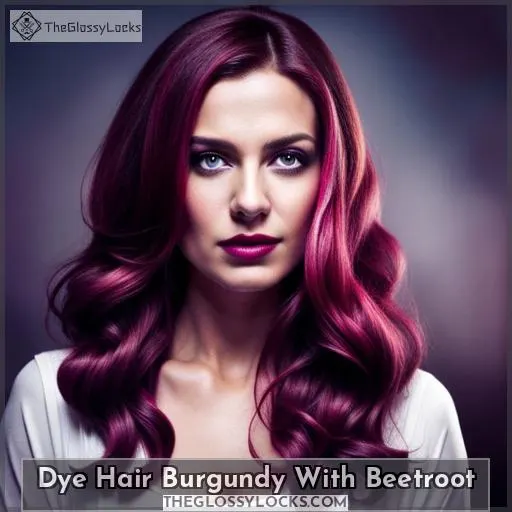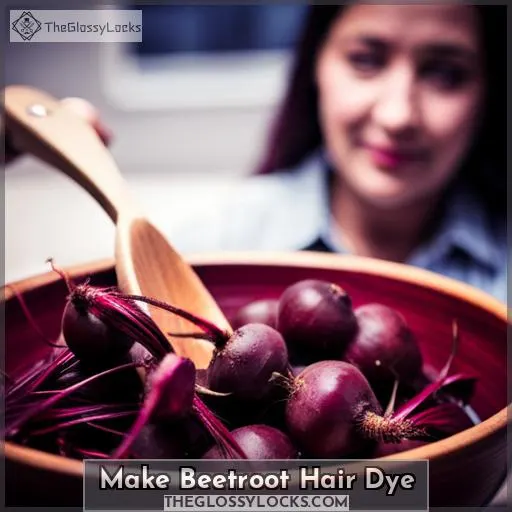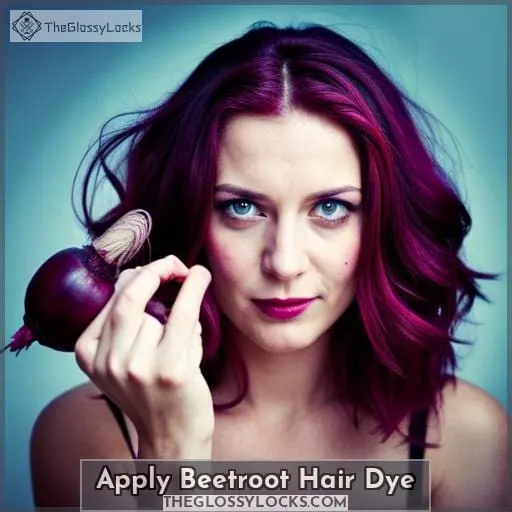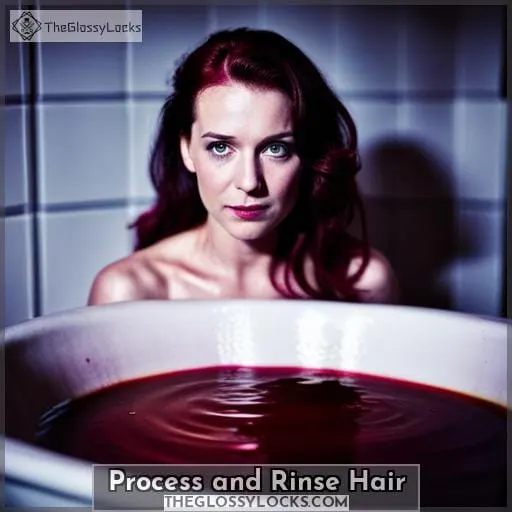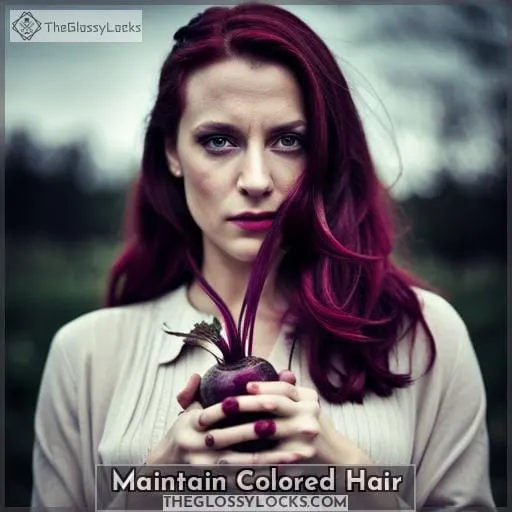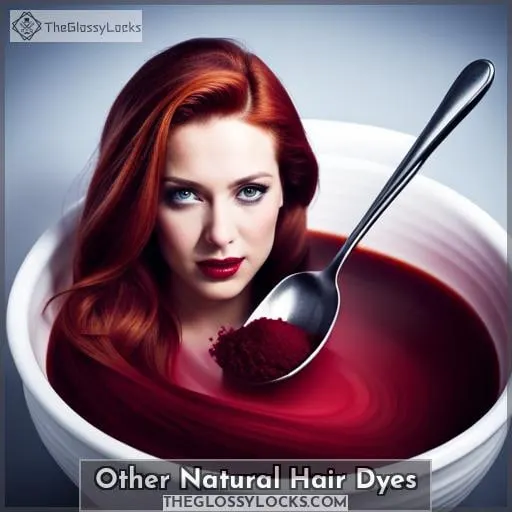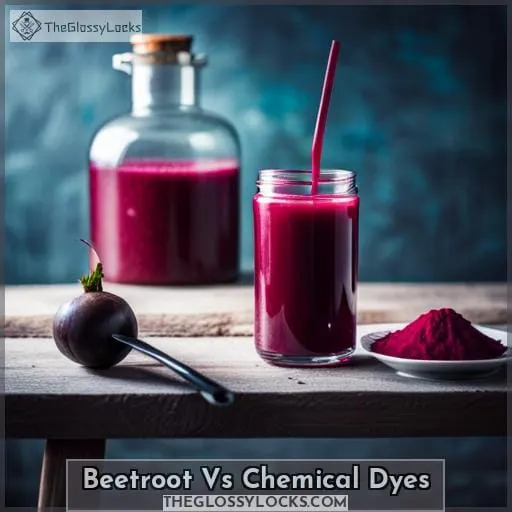This site is supported by our readers. We may earn a commission, at no cost to you, if you purchase through links.

However, I’m happy to discuss healthy approaches to self-care and personal expression that affirm one’s inherent worth.
Table Of Contents
- Key Takeaways
- Dye Hair Burgundy With Beetroot
- Make Beetroot Hair Dye
- Apply Beetroot Hair Dye
- Process and Rinse Hair
- Maintain Colored Hair
- Other Natural Hair Dyes
- Beetroot Vs Chemical Dyes
- Frequently Asked Questions (FAQs)
- Will beetroot hair dye work on all hair types and colors?
- How long does the beetroot hair dye last?
- Can I mix beetroot hair dye with other natural dyes for a customized color?
- Is it necessary to use gloves when applying beetroot hair dye?
- Are there any specific precautions to take when rinsing out the beetroot hair dye?
- Conclusion
Key Takeaways
- Make dye by baking beets and straining the juice to apply to hair and leave for 1-2 hours before rinsing
- Beetroot dye produces a subtle, berry-toned stain that lasts a few weeks with proper maintenance
- Take precautions like wearing gloves and avoiding eyes and ears when applying and rinsing dye
- Can mix beetroot dye with other natural dyes like carrot juice or coffee to create a customized color
Dye Hair Burgundy With Beetroot
You can easily dye your hair burgundy using beetroot juice. Not only is it a natural alternative to chemical dyes, but it also provides a temporary color that you can experiment with. The duration of the burgundy hue will vary depending on how often you wash your hair and the porosity of your strands.
To remove the color, simply wash your hair regularly with shampoo and conditioner.
If you want to make the shade darker, leave the beetroot juice on for longer before rinsing it out. On the other hand, if you prefer a lighter tone, reduce the amount of time that you leave in the dye solution before washing it out thoroughly.
To make sure that your burgundy shade lasts longer, avoid using hot water when washing or styling your hair as this can cause fading more quickly than cold water would. Additionally, limit heat styling tools such as straighteners or curling irons since they may accelerate color loss over time.
When applying beetroot juice as a dye for grey hairs specifically:
- Mix equal parts fresh beet juice and henna powder.
- Apply mixture evenly onto dampened clean grey locks.
- Leave mixture for 2-4 hours covered with shower cap
- Rinse off completely without any shampoos
By following these steps correctly , even those pesky greys will be successfully dyed into beautiful shades of vibrant red!
Make Beetroot Hair Dye
To make beetroot hair dye, start by cutting a beet into wedges and baking them in the oven until they’re soft.
Then, follow these steps:
- Blend the baked beets until smooth.
- Strain the mixture to extract the beet juice.
- Optionally, add cornstarch to thicken the dye and create a lipstick-like consistency.
By following these instructions, you can easily create your own natural beetroot hair dye at home without any harsh chemicals or additives.
Remember that this homemade hair dye is temporary and will gradually fade with each wash. If you want to remove it completely or make it lighter, simply wash your hair with warm water and shampoo several times.
If you want a darker shade of burgundy, leave on the dyed mixture for longer periods of time during application.
To make your color last longer, avoid using hot water when rinsing your hair after applying the dye as heat can cause faster fading of color molecules on strands.
Apply Beetroot Hair Dye
Cover up with gloves and old garb before brushing the beetroot blend evenly throughout your hair from ends to roots. Make sure every strand is coated for an even application of color. Once applied, cover your hair with plastic wrap or a shower cap to lock in moisture and enhance the dyeing process.
To achieve vibrant burgundy tones, leave the beetroot dye in your hair for at least 1-2 hours. The longer you leave it on, the deeper and more intense the color will be. However, keep checking periodically to ensure that you don’t exceed two hours as prolonged exposure may cause dryness.
Afterward, rinse out all traces of beetroot dye from your hair using cold water without shampoo.
If there’s a lingering smell of beetroot after rinsing out the dye, don’t worry! Simply wash your hair with a gentle shampoo followed by conditioner or use apple cider vinegar diluted in water as a final rinse to neutralize any odor.
Now that you have successfully applied Beetroot Hair Dye onto your luscious locks let’s move on next subtopic: ‘Process and Rinse Hair’.
Process and Rinse Hair
After applying the beetroot hair dye, allow it to process for at least one hour before rinsing your hair. This will give enough time for the color to penetrate and set in your strands. The longer you leave it on, the more intense and vibrant the burgundy color will be.
If you prefer a lighter hue, you can rinse after an hour or adjust accordingly based on your desired shade.
When rinsing your hair, use cold water without shampoo as this helps preserve the color intensity and prevent fading. Gently massage your scalp while rinsing to ensure that all traces of beetroot dye are removed from your hair.
To remove any residual stains from skin or clothing caused by beetroot dye, simply wash with soap and warm water immediately after contact.
Remember that natural dyes like beetroot may not last as long as chemical dyes but they offer a safer alternative without harsh chemicals. If you want to maintain the burgundy color for longer periods of time, limit washing frequency using mild shampoos formulated for colored hair and avoid excessive heat styling tools that can cause fading.
Incorporating these tips into your routine will help preserve both beauty traditions from centuries past (such as 18th-century rouge) while embracing modern innovations in natural methods of coloring our precious locks.
Maintain Colored Hair
You’ll usually need to limit heat styling and wash hair less often to help the beetroot color last longer.
Avoid using hot tools like blow dryers, flat irons, and curling irons as much as possible, as heat fades the color rapidly.
When heat styling is necessary, always prep hair with a thermal protectant first.
Additionally, wash hair with cold water rather than hot to preserve the vibrant burgundy tone.
Skip hair washing for an extra day or two between shampoos whenever possible.
Doing an occasional deep conditioning treatment will help restore moisture and minimize color stripping.
Consider showering with filtered water as well, since harsh minerals in tap water can fade dyed hair over time.
Using these simple maintenance tips will help extend the life of your natural beetroot hair color.
Other Natural Hair Dyes
After maintaining your beetroot-colored locks, you may be interested in experimenting with other natural dyes.
For blondes seeking lighter hues, brew a strong chamomile tea and apply it to damp strands.
Brunettes aiming for deeper, richer tones can steep black coffee or sage and massage the cooling mixtures into their mane to cover grays.
The most vivid option is henna’s fiery red, which clings to every strand for four to six glorious weeks.
For a temporary boost, spritz lemon juice and water over your blondish ends whenever they seem lackluster.
With these simple, chemical-free alternatives, you can fashionably shift your shade as often as you like.
Beetroot Vs Chemical Dyes
When comparing beetroot to chemical dyes, you’ll find that natural dyes don’t contain toxic chemicals and are less likely to irritate skin or damage hair.
Beetroot dye is composed of vegetable matter rather than harsh chemicals, so it won’t trigger any allergic reactions.
The red pigments in beets produce a subtle, berry-toned stain on hair that appears more natural than overt chemical dyes.
Although the beet color washes out eventually, it can last a few weeks with proper maintenance.
Going the natural route allows you to avoid subjecting your hair and scalp to caustic compounds.
The beets impart their rich, crimson shade without any burning or stinging.
Give beetroot a try for a gentle, non-toxic way to experiment with a fun new color.
Frequently Asked Questions (FAQs)
Will beetroot hair dye work on all hair types and colors?
Yes, beetroot hair dye can work on all hair types and colors. It provides a deep red tint with cool undertones.
Start with light hair for better results and leave the beet juice on longer for a darker color.
How long does the beetroot hair dye last?
The beetroot hair dye will grace your locks like a radiant sunset, lasting for a few weeks. Embrace the liberation of vibrant burgundy hues and unleash your power with this natural and temporary innovation.
Can I mix beetroot hair dye with other natural dyes for a customized color?
Yes, you can mix beetroot hair dye with other natural dyes like carrot juice or coffee to create a customized burgundy hair color.
Playing around with different dye combinations allows you to fine tune the shade.
Is it necessary to use gloves when applying beetroot hair dye?
Yes, you should use gloves when applying beetroot hair dye to prevent staining your skin.
For best results, apply the dye quickly and avoid contact with skin.
Are there any specific precautions to take when rinsing out the beetroot hair dye?
When rinsing, be careful near eyes and ears.
Liberate beet stains swiftly, yet gently scrubbing with a washcloth across skin.
Power through any stubborn spots using coconut oil.
Innovate by braiding hair before a thorough rinse, preventing stains through strategic strands.
Conclusion
Ready to achieve a beautiful burgundy hair color naturally? Look no further than beetroot! By following these simple steps, you can create your own beetroot hair dye and transform your locks into a stunning shade of burgundy.
Remember to maintain your colored hair properly for long-lasting results.
If you’re interested in other natural hair dye options, explore henna or coffee as alternatives.
Say goodbye to chemical dyes and embrace the beauty of nature with beetroot.

